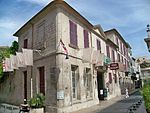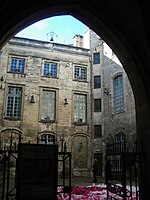Pont Saint-Bénézet

The Pont Saint-Bénézet (French pronunciation: [pɔ̃ sɛ̃ benezɛ]; Provençal: Pònt de Sant Beneset), also known as the Pont d'Avignon (IPA: [pɔ̃ daviɲɔ̃]), was a medieval bridge across the Rhône in the town of Avignon, in southern France. Only four arches survive. A wooden bridge spanning the Rhône between Villeneuve-lès-Avignon and Avignon was built between 1177 and 1185. This early bridge was destroyed forty years later in 1226 during the Albigensian Crusade when Louis VIII of France laid siege to Avignon. Beginning in 1234 the bridge was rebuilt with 22 stone arches. The stone bridge was about 900 m (980 yd) in length and only 4.9 m (16 ft 1 in) in width, including the parapets at the sides. The bridge was abandoned in the mid-17th century as the arches tended to collapse each time the Rhône flooded making it very expensive to maintain. Four arches and the gatehouse at the Avignon end of the bridge have survived. The Chapel of Saint Nicholas which sits on the second pier of the bridge, was constructed in the second half of 12th century but has since been substantially altered. The western terminus, the Tour Philippe-le-Bel, is also preserved. The bridge was the inspiration for the song Sur le pont d'Avignon and is considered a landmark of the city. In 1995, the surviving arches of the bridge were classified as a World Heritage Site, together with the Palais des Papes, Cathédrale Notre-Dame des Doms, and other monuments from the historic centre of Avignon, because of its testimony to Avignon's leading role in the Papacy during the 14th and 15th centuries.
Excerpt from the Wikipedia article Pont Saint-Bénézet (License: CC BY-SA 3.0, Authors, Images).Pont Saint-Bénézet
Boulevard du Quai de la Ligne, Avignon Quartier Centre
Geographical coordinates (GPS) Address Nearby Places Show on map
Geographical coordinates (GPS)
| Latitude | Longitude |
|---|---|
| N 43.953888888889 ° | E 4.805 ° |
Address
Pont Saint-Bénezet
Boulevard du Quai de la Ligne
84000 Avignon, Quartier Centre
Provence-Alpes-Côte d'Azur, France
Open on Google Maps











